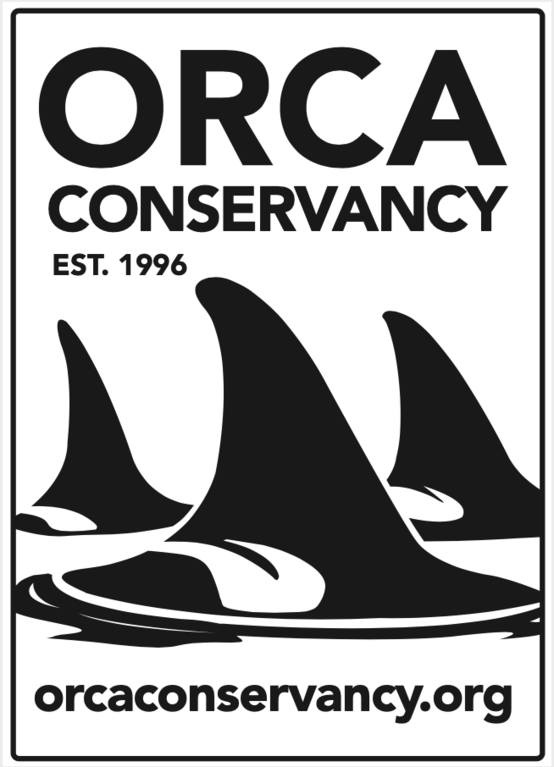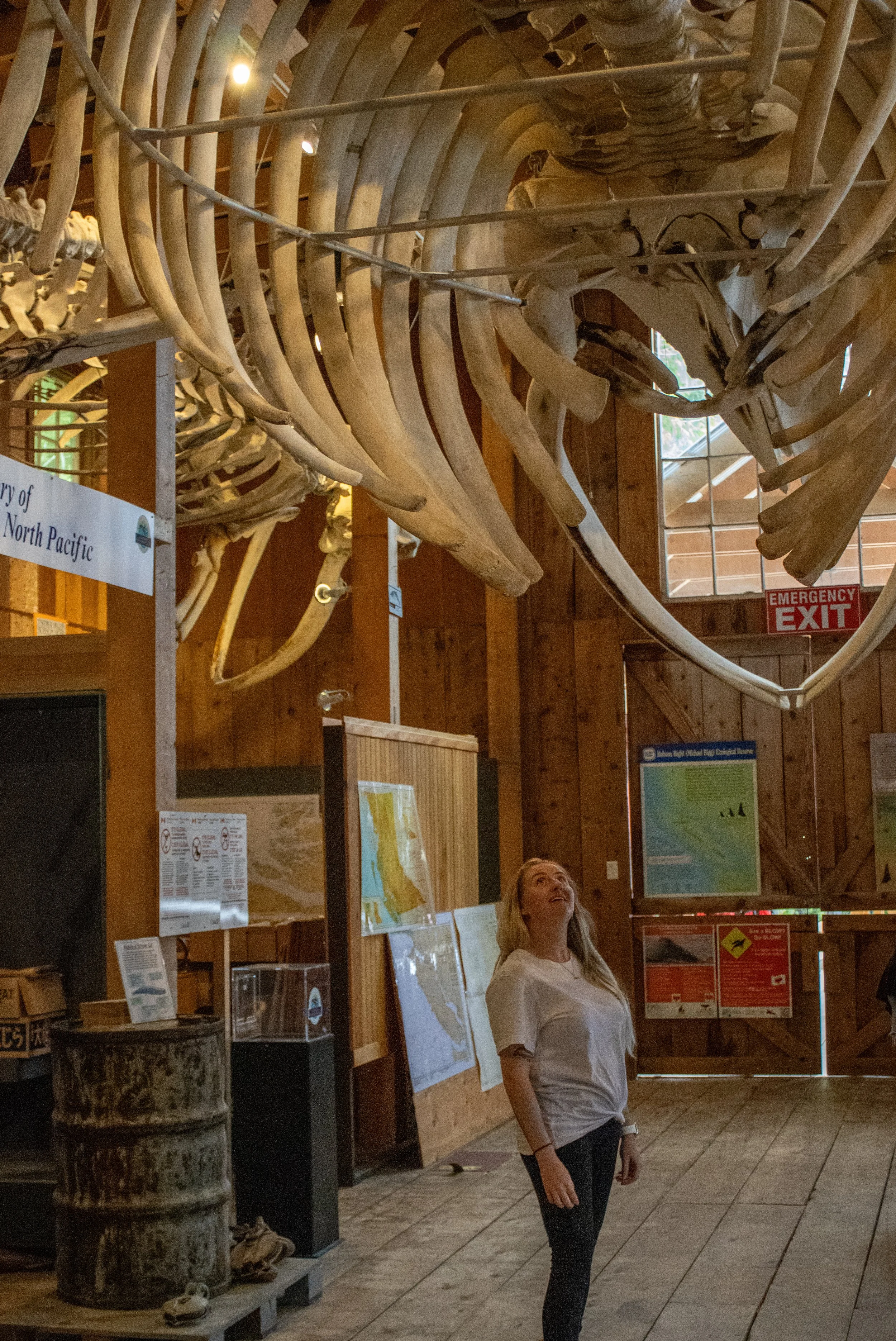Help Rebuild The Whale Interpretive Centre in Telegraph Cove
Many of us awoke to devastating news on December 31st, 2024: Parts of the boardwalk in Telegraph Cove were engulfed in flame. Due to the fire occurring during the off-season, no one was harmed, but the fire destroyed homes and local businesses like The Whale Interpretive Centre, The Killer Whale Cafe, the Old Saltery Pub, Prince of Whales, and Tide Rip Grizzly Tours. Gordie Graham, co-founder of Telegraph Cove Resort, shared on January 1, 2025 that the cause of the fire is still under investigation.
Telegraph Cove is located on Northern Vancouver Island, on the territory of the Kwakwa̱ka̱ʼwakw and Kwak̕wala-speaking Peoples. It is just north of Robson Bight Ecological Reserve. It was established by settlers in 1912 from a one-room station at the northern terminus of the Campbell River telegraph line built by the federal government. Telegraph Cove was home to a small sawmill and chum salmon cannery through the 1980s(1).
Telegraph Cove Resort
Today, Telegraph Cove is owned and operated by The Telegraph Cove Resort and The Telegraph Cove Marina and RV Park. The resort was first created by Gordie and Marilyn Graham in 1979, who continually restored the buildings and structures of the area to maintain the historical roots. In 1998 they expanded to build and restaurant and pub, general store, small hotel and a sewage treatment plant to support the increase in ecotourism to the area.
BC’s First Whale Watching Company
The whale community worldwide likely knows Telegraph Cove as the home to the first whale-watching company in British Columbia, Stubbs Island Whale Watching, established in 1980. Stubbs originally started as a dive operation by Jim Borrowman and Bill McKay. As interest in viewing whales grew, the company shifted to offering ethical opportunities to watch whales from Telegraph Cove. Stubbs Island Whale Watching operated for 38 years, closing in 2018 (3).
The Whale Interpretive Centre
In 1993, the Johnstone Strait Killer Whale Interpretive Centre Society was established by the Board of Directors, which comprised conservationists, scientists, and local residents. The foundation of the WIC’s collection was formed from Jim Borrowman’s marine mammal skeleton collection, and both he and his wife Mary Borrowman remain actively involved in the WIC and the Strait Killer Whale Interpretive Centre Society today. In 2002, they opened The Whale Interpretive Centre (WIC)in Telegraph Cove, to provide an educational centre to help increase public awareness about the biology of marine mammals and the threats they are facing. WIC was also opened due to a recommendation from the government to have an educational centre on the North Island as Robson Bight Ecological Reserve was nearby (4).
WIC housed the largest public collection of marine mammal skeletons in British Columbia and touched the lives of 10,000 tourists every year.
The fire on December 31st destroyed the centre in it’s entirety. Skeletons of killer whales, a beluga whale, Cuvier’s beaked whale, a Pacific white-sided dolphin, grey whale, minke whale, and many others have been lost. The collection was valued at $2 million but there is truly no monetary value that can be accurately assigned to the incredible impact that The Whale Interpretive Centre had on people around the world.
“On behalf of the board of directors of the Whale Interpretive Centre it is with heavy hearts that we let you know the WIC and its wonderful collection of marine mammal skeletons did not survive the devastating fire of the morning of December 31, 2024. As the sun rises on this new day and a brand-new year begins, let it be a reminder that each moment holds the potential for growth, change and new beginnings. Together we will embrace the challenge for renewed strength to what lays ahead.”
Jim and Mary Borrowman, Telegraph Cove BC
Support the Ongoing Rebuild Efforts
Like many of you, we have our own memories of Telegraph Cove that we will treasure forever.
The Whale Interpretive Centre has shared a fundraiser for the rebuilding efforts. The starting goal is to raise $1 million to help rebuild what was lost and restore and add to the amazing collection they had so it can be shared for generations to come. Every contribution, no matter the size, will directly fund the rebuilding process.
Rebuild Update:
As of July 2025, the WIC has announced that they will be opening an interim structure on the boardwalk called the Whale Shed! It will showcase newly articulated Risso Dolphins and Pygmy Sperm Whale skeletons, along with new skulls and bones donated by Dr. Dave Duffus and colleagues. The Whale Shed is expected to open mid-July and remain open until the end of September.
Memories We Hold Dear
We wanted to share some of our stories from Telegraph Cove to remember this incredible place throughout the years.
Dr David Bain, Chief Scientist
The fire at Telegraph Cove destroyed over 4 decades of history. I can't cover all the important things that happened there in a single post. So, this is the first of what I hope will be many tributes I can pay to the people who lived and worked there, and lost an important part of our lives as 2024 came to an end.
Telegraph Cove was home to Stubbs Island Charters, a diving company that got into whale watching. They understood the importance of conservation. They were leaders in the effort to protect the Tsitika River watershed from logging. While they weren't able to protect all of it, they did protect a lot of it.
They also helped establish a no-go zone for whale watching boats, despite the fact they'd become a whale watching company. They recognized the importance of what is now known as the Robson Bight (Michael Bigg) Ecological Reserve. It's a place Northern Residents go to rub on gravel that's big enough to remove parasites but small enough that it doesn't have any sharp edges. Left undisturbed, the whales would spend about 2.4 hours per day there. When boats were close, they'd only spend seconds rubbing, if that.
It is a reflection of the character of the permanent residents of Telegraph Cove that they placed the environment first rather than trying to make as much money as possible. I hope they will be able to rebuild as a reminder of how people can co-exist with nature.
--Dave
Tamara, Director of Development
Tamara Kelley in the WIC in June 2024 | By Kendra Nelson
I first visited Telegraph Cove as a teenager in the summer of 2003 on a family trip. My family booked this trip with the hopes of seeing the Northern Resident killer whales. During our visit, we stayed in Cabin 3 of the Telegraph Resort, which is a small, picturesque house nestled in the hill right above the end of the boardwalk. Luckily, despite the proximity to the fire, this cabin was spared.
I have a very fond memory of that stay. In the living room and shared space of Cabin 3, there are large windows that overlook the boardwalk and out into the main channel. Sitting on the coffee table was a small stack of literature, which included an ID guide of the cataloged Transient (mammal-eating) killer whale population. I was quite fortunate growing up to have had the opportunity to regularly see the Southern Resident killer whales (SRKWs); however, at that time, Transients were quite rare in my area. For me, Transients were like this elusive and exotic orca that I wished to see someday. Of course, fast forward to now, they are seen far more frequently than the SRKWs. Nevertheless, here I was, this young teenage girl obsessed with orcas and specifically Transients (Ts), so to flip through the ID guide and see all the different individuals was quite an exciting thing for me. Especially because this was before Facebook, and resources like this were much harder to come by.
One of the days during this trip, my family chartered an early morning fishing charter. Both my brother and dad caught salmon, meanwhile, I spent the entire trip chatting the Captain’s (Gordy) ear off and insisted on hearing all of his fisherman tales of killer whales. I recall him telling me a story of witnessing an orca snatch a deer swimming in the water and another graphic story of a pod of Ts herding dolphins into a cove. I couldn’t get enough of it!
Transients were much more common in this area, and I had hoped to be able to see some, while the whole family was also hoping to see A73 Springer. But it was not to be on that trip. And while we didn’t see Springer or Ts, we did see some orcas none of us had ever seen before! My parents booked our family on a whale watch boat with Stubb’s Island Whale Watching. Historically, we had always done whale watching from shore, so this was our first ever trip on a whale watch boat and something I was so excited for. During our trip, we saw Northern Resident killer whales, and a minke whale, which I didn’t even know existed! I had always recalled that the pod of NRKWs we had seen was members of one of the A pod matrilines, but after recruiting some help from the wonderful folks at the WIC, I have now learned that we actually saw the B1 Pod and B7 matriline (part of A Clan), including B10 Slingsby (deceased) who was easily recognized by his crinkled dorsal fin, and B13 Yuculta before his dorsal fin fully collapsed!
From left to right: B13 Yuculta, B10 Slingsby, and another member of the B7s | Taken by Jim Kelley 2003
Since that family vacation, I wouldn’t return to Telegraph Cove for another 21 years, until the summer of 2024, when friends and colleagues in Canada invited me on a short weekend road trip to attend the Coastal Insights event. Despite two decades passing and a few changes, the town felt almost untouched, as if it had been preserved in time. It was such a full-circle moment, returning as an adult working in orca conservation to a place that influenced my life and trajectory in this field. I will be returning again this summer, and while I expect things to look a little different this time, I know that the impact and the significance of this place to not just me, but to the PNW whale community, will always remain unchanged.
Shari, Executive Director: From the moment I arrived in Telegraph Cove back in 2015, I was struck by the quiet charm of the cove that felt like stepping back in time, with its weathered boardwalks, and colorful historic buildings. The marina was dotted with fishing charters, whale-watching vessels, and sleek private boats, it served as both a hub of activity and a window into local seafaring culture.
Northern Resident killer whales | Blackfish Sound | Shari Tarantino
Humpacks | Blackfish Sound | Shari Tarantino
The most memorable part of my journey was staying on nearby Hanson Island (Yukusam, in the unceded territory of the Kwakwa̱ka̱ʼwakw peoples) at OrcaLab. There, I was fortunate to witness the rich tapestry of marine life that calls this region home. I listened in awe as the calls of Northern Resident killer whales echoed through the hydrophones and watched as they swam past the island merely a few feet away! Humpback whales surfaced nearby, their massive forms breaking the water with a grace that never ceased to amaze me. Pacific white-sided dolphins (Lags), playful sea otters, and curious sea lions were frequent visitors.
My time in Telegraph Cove and on Hanson Island was more than just a visit; to this day, it continues to serve as a profound reminder to protect the delicate balance that sustains ALL interconnected ecosystems.
Photo from Shari Tarantino, OC Executive Director, who visited in 2015.





